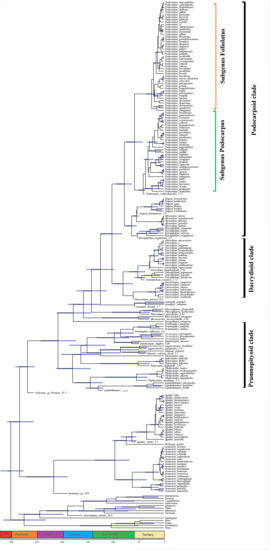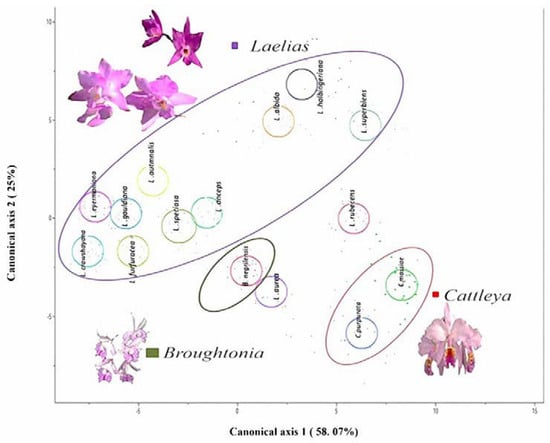Advances in Plant Diversification and Biosystematics
Share This Topical Collection
Editors
 Dr. Ângela Sartori
Dr. Ângela Sartori
 Dr. Ângela Sartori
Dr. Ângela Sartori
E-Mail
Website
Collection Editor
Laboratório de Sistemática Vegetal, Instituto de Biociências, UFMS, Avenida Costa e Silva, S/nº, Bairro Universitário, Campo Grande CEP 79070-900, MS, Brazil
Interests: plant taxonomy; revisionary and floristic work; leaf morphology; Fabaceae
Topical Collection Information
Dear Colleagues,
Plant diversification and biosystematics are closely linked areas of knowledge. Methods in plant systematics are changing, as new technological advances offer more effective and powerful tools to deepen our knowledge about plant diversification and to better support conservation planning and management.
Endangered plant species, as well as orphan crop species, are hidden resources for a sustainable ecosystem and continuous developmental agricultural system. Tracing back into plant evolutionary history and the molecular genetics of plant geo-diversifications will provide useful information on how scientists can better engineer environmentally adaptable plant/crop species for surviving and thriving under current/future climate changes. These efforts are also crucial to ensure the sustainable use of plant species and irreplaceable resources for food security, nutrition, and human well-being.
We hope that this Topical Collection will be a significant step towards understanding plant diversification and other aspects related to plant systematics.
Dr. Yang Liu
Dr. Ângela Sartori
Collection Editors
Manuscript Submission Information
Manuscripts should be submitted online at www.mdpi.com by registering and logging in to this website. Once you are registered, click here to go to the submission form. Manuscripts can be submitted until the deadline. All submissions that pass pre-check are peer-reviewed. Accepted papers will be published continuously in the journal (as soon as accepted) and will be listed together on the collection website. Research articles, review articles as well as short communications are invited. For planned papers, a title and short abstract (about 100 words) can be sent to the Editorial Office for announcement on this website.
Submitted manuscripts should not have been published previously, nor be under consideration for publication elsewhere (except conference proceedings papers). All manuscripts are thoroughly refereed through a single-blind peer-review process. A guide for authors and other relevant information for submission of manuscripts is available on the Instructions for Authors page. Plants is an international peer-reviewed open access semimonthly journal published by MDPI.
Please visit the Instructions for Authors page before submitting a manuscript.
The Article Processing Charge (APC) for publication in this open access journal is 2700 CHF (Swiss Francs).
Submitted papers should be well formatted and use good English. Authors may use MDPI's
English editing service prior to publication or during author revisions.
Keywords
- plant systematics
- orphan crop species
- phylogenomics
- phylogenetics
- population genetics
- plant community ecology
- biogeography
- plant diversity
- taxonomy
Published Papers (3 papers)
2023
Open AccessArticle
Detailed Seed Cone Morpho-Anatomy Provides New Insights into Seed Cone Origin and Evolution of Podocarpaceae; Podocarpoid and Dacrydioid Clades
by
Raees Khan, Robert S. Hill, Veit M. Dörken and Ed Biffin
Cited by 1 | Viewed by 1147
Abstract
The study of reproductive morphology and trait evolution provides a vital insight to understand the evolutionary history of plants. The conifer family Podocarpaceae has a remarkable diversity of seed cones, with distinct morphology among the genera and with conifers in general. However, we
[...] Read more.
The study of reproductive morphology and trait evolution provides a vital insight to understand the evolutionary history of plants. The conifer family Podocarpaceae has a remarkable diversity of seed cones, with distinct morphology among the genera and with conifers in general. However, we lack a good understanding of the seed cone morpho-anatomy and trait evolution of Podocarpaceae. We investigated detailed seed cone morpho-anatomy using staining and sectioning techniques to clarify the anatomical, morphological diversity and evolution of functional traits. The presence of a fleshy receptaculum is a characteristic feature of both clades. However, species of
Retrophyllum, Afrocarpus and some species of
Nageia and
Podocarpus form a fleshy sarcotesta-like seed coat, lacking a fleshy receptaculum. The ancestral state reconstructions show a shift between and sometimes within the genus. Although both clades demonstrate fleshiness as an ancestral trait, the shift in fleshy structures provides evidence for complex multiple evolutions of fleshy morphologies. These seed cone traits (e.g., fleshiness and size), along with the broad, flattened and well-adapted (leaf dimorphism) foliage in both clades, are largely congruent with efficient light harvesting and bird dispersal. These traits make these two clades well adapted to their environment, when growing in communities including tall and broad-leaved angiosperms (closed-canopy angiosperm forests), compared to other podocarps, making them more successful in achieving a wider distribution and species richness.
Full article
►▼
Show Figures
Open AccessArticle
Diversity, Distribution, Systematics and Conservation Status of Podocarpaceae
by
Raees Khan, Robert S. Hill, Jie Liu and Ed Biffin
Cited by 3 | Viewed by 3691
Abstract
Among conifer families, Podocarpaceae is the second largest, with amazing diversity and functional traits, and it is the dominant Southern Hemisphere conifer family. However, comprehensive studies on diversity, distribution, systematic and ecophysiological aspects of the Podocarpaceae are sparse. We aim to outline and
[...] Read more.
Among conifer families, Podocarpaceae is the second largest, with amazing diversity and functional traits, and it is the dominant Southern Hemisphere conifer family. However, comprehensive studies on diversity, distribution, systematic and ecophysiological aspects of the Podocarpaceae are sparse. We aim to outline and evaluate the current and past diversity, distribution, systematics, ecophysiological adaptations, endemism, and conservation status of podocarps. We analyzed data on the diversity and distribution of living and extinct macrofossil taxa and combined it with genetic data to reconstruct an updated phylogeny and understand historical biogeography. Podocarpaceae today contains 20 genera and approximately 219 taxa (201 species, 2 subspecies, 14 varieties and 2 hybrids) placed in three clades, plus a paraphyletic group/grade of four distinct genera. Macrofossil records show the presence of more than 100 podocarp taxa globally, dominantly from the Eocene–Miocene. Australasia (New Caledonia, Tasmania, New Zealand, and Malesia) is the hotspot of living podocarps diversity. Podocarps also show remarkable adaptations from broad to scale leaves, fleshy seed cones, animal dispersal, shrubs to large trees, from lowland to alpine regions and rheophyte to a parasite (including the only parasitic gymnosperm—Parasitaxus) and a complex pattern of seed and leaf functional trait evolution.
Full article
►▼
Show Figures
Open AccessArticle
Contribution of Morphoanatomic Characters to the Taxonomy of the Genus LAELIA (Orchidaceae) in Mexico and Their Implication in Environmental Adaptation
by
Montserrat Castellanos-Ramírez, Ulises Rosas, María Concepción Guzmán-Ramos and Estela Sandoval-Zapotitla
Cited by 1 | Viewed by 1656
Abstract
The Laeliinae Subtribe (Epidendroideae-Orchidaceae) is exclusively Neotropical, composed of 43 genera and 1466 species, presenting great floral and vegetative diversity. The genus
Laelia has restricted geographic distribution, with species in Brazil and Mexico. However, in molecular studies, the Brazilian species have not been
[...] Read more.
The Laeliinae Subtribe (Epidendroideae-Orchidaceae) is exclusively Neotropical, composed of 43 genera and 1466 species, presenting great floral and vegetative diversity. The genus
Laelia has restricted geographic distribution, with species in Brazil and Mexico. However, in molecular studies, the Brazilian species have not been included despite remarkably similar floral structures in both Mexican and Brazilian groups of species. The main objective of the present study is to analyze vegetative structural characters of 12 species of
Laelia in Mexico to find similarities to recognize them as a taxonomic group and their relationship with possible ecological adaptations. This work supports the proposal to recognize 12 species of Laelias from Mexico as a taxonomic group (except for the new species recognized as
Laelia dawsonii J. Anderson), since a strong similarity was found, translated by 90% of structural characters shared by the Mexican Laelias, given the relationship between the structural characters and the altitudinal distribution in which the groups of Mexican Laelias species are found. We propose that Laelias of Mexico be recognized as a taxonomic group and their structural characteristics allow for better understanding of adaptation of species to their environment.
Full article
►▼
Show Figures










